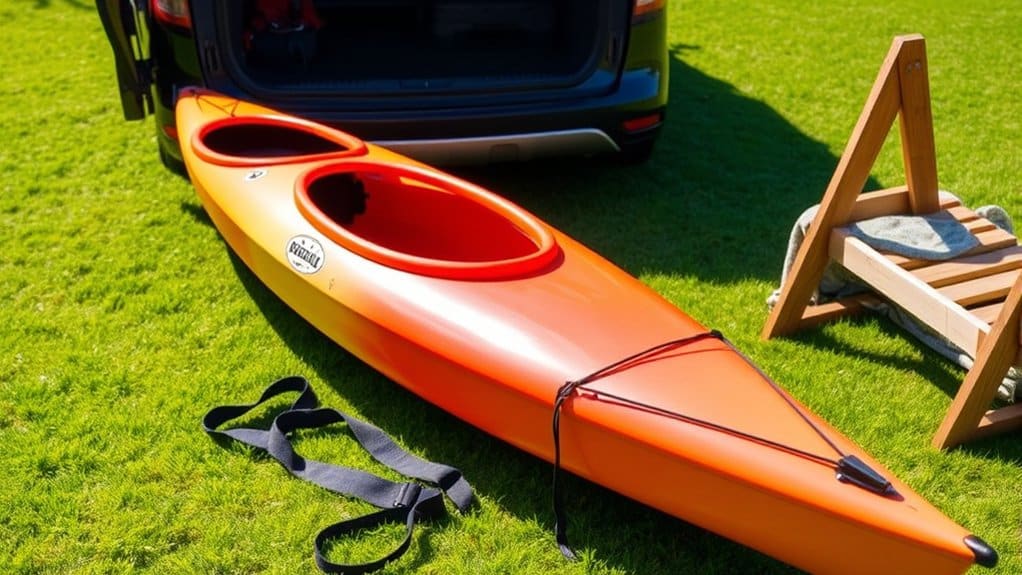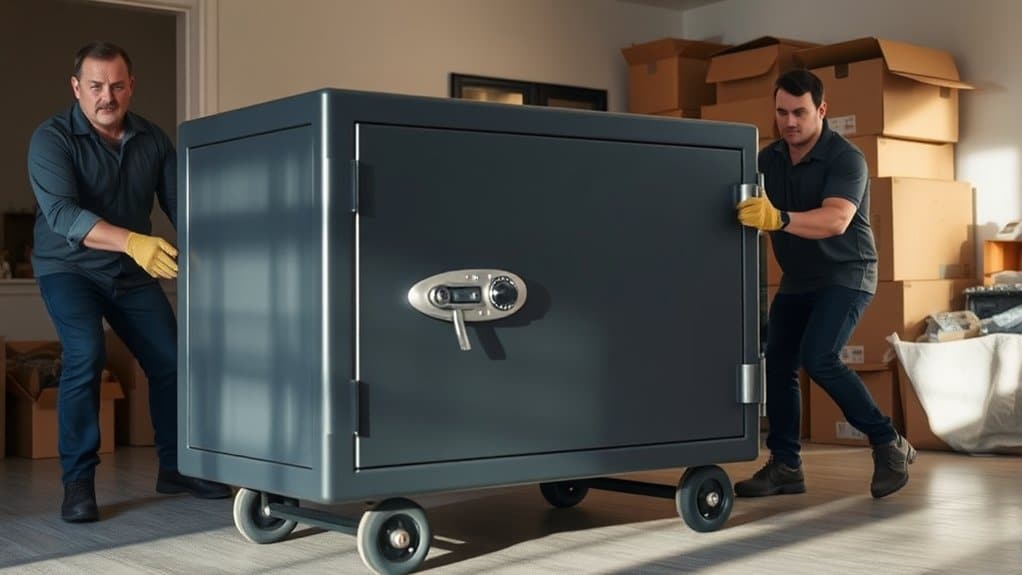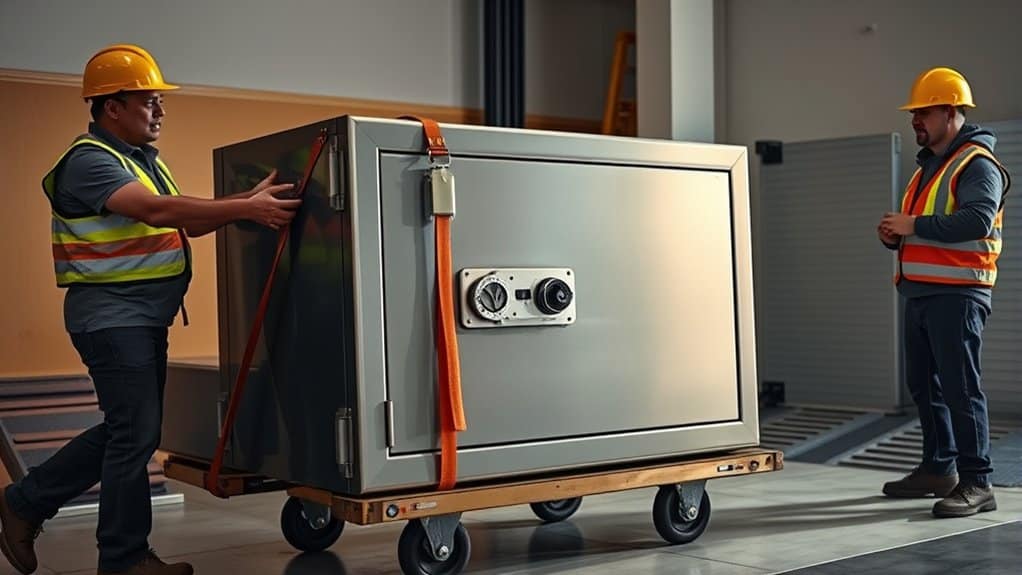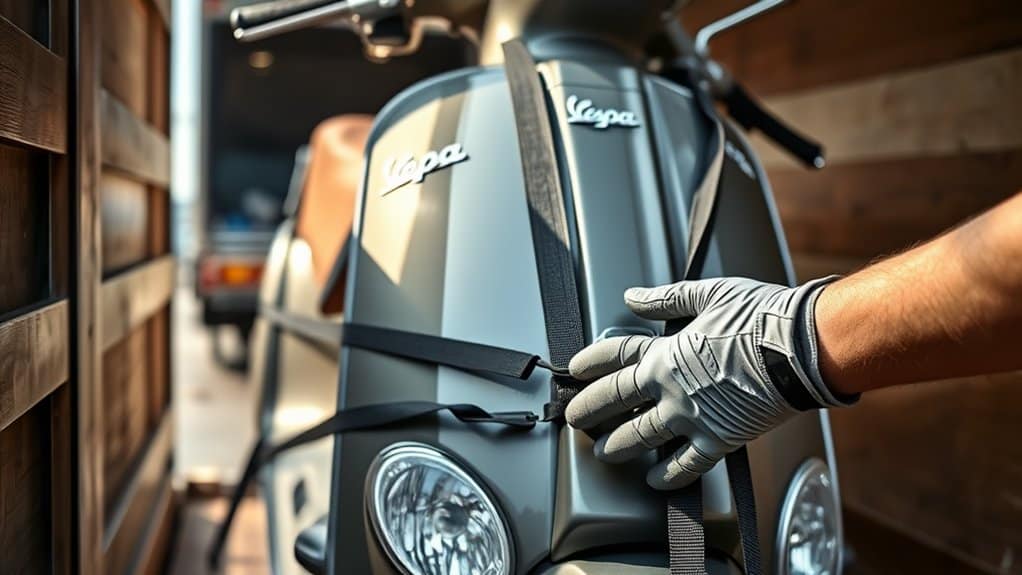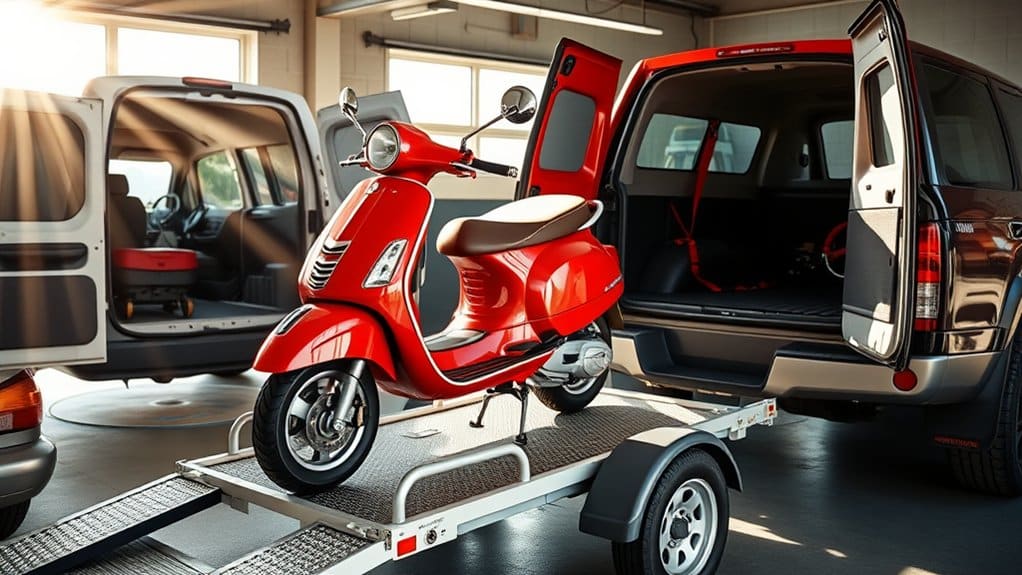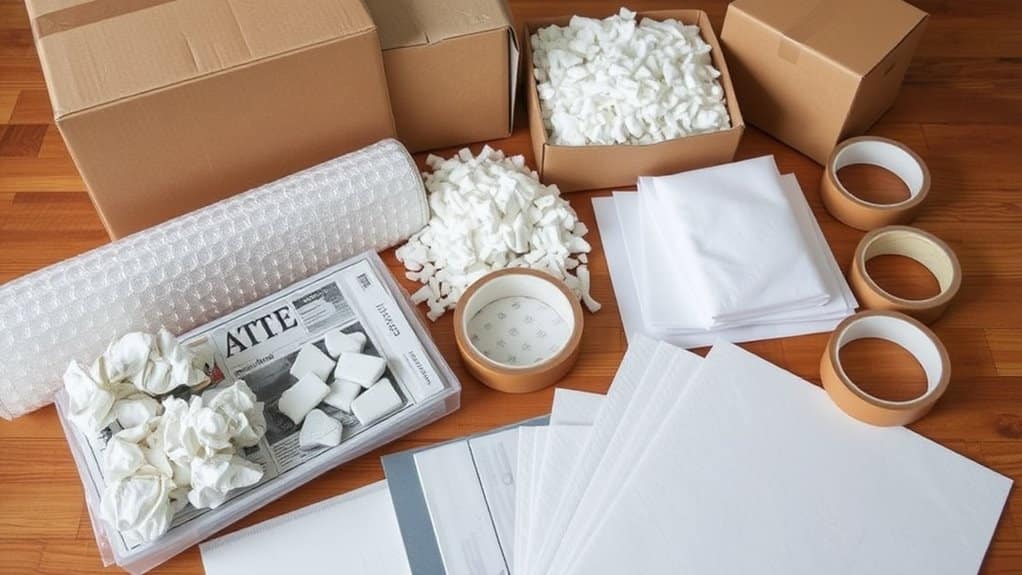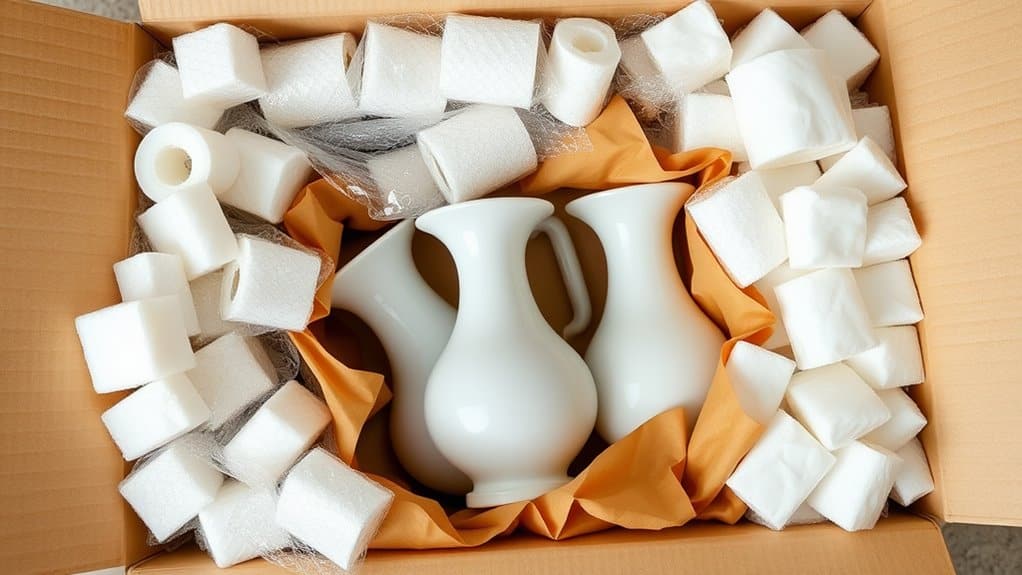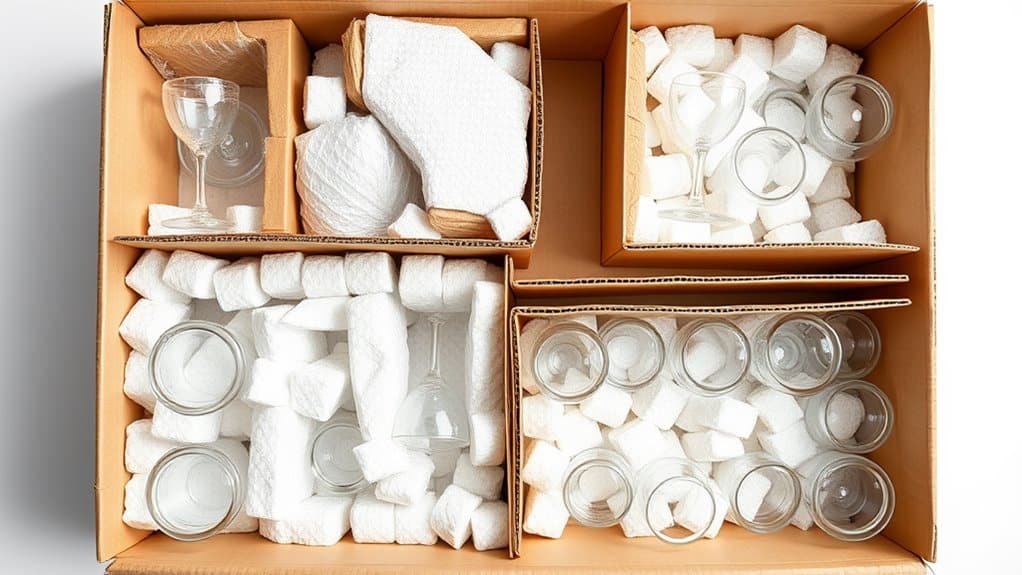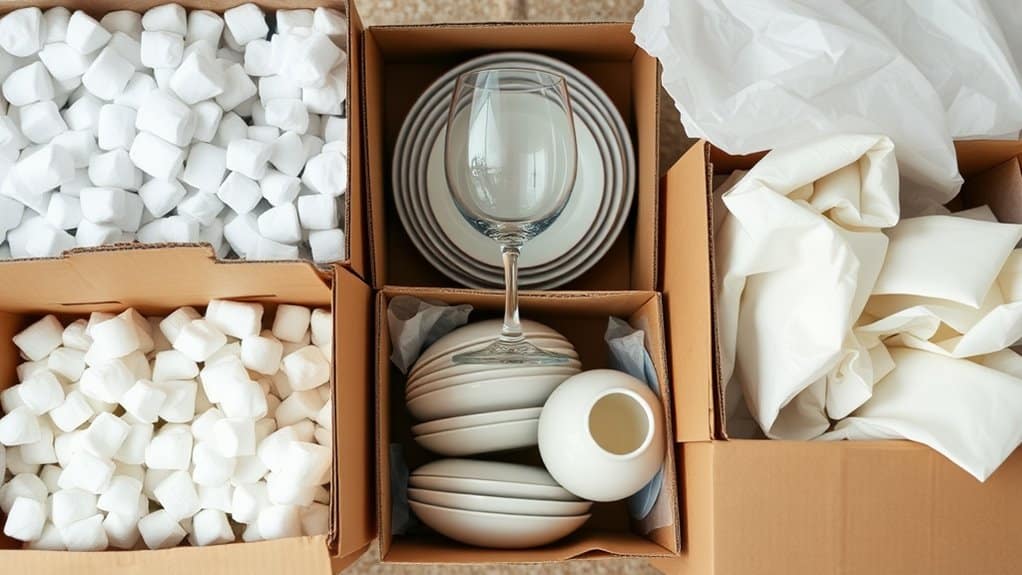To pack fragile items safely, you'll need quality packing materials including bubble wrap, packing paper, and sturdy boxes with corrugated walls. Start by cleaning each item and wrapping them individually, using extra cushioning for delicate areas. Create a protective base layer in your box using 2-3 inches of bubble wrap or crumpled paper. Place items carefully, filling empty spaces with packing materials to prevent movement. Seal boxes thoroughly with heavy-duty tape along all seams, and clearly mark them as "Fragile." For valuable pieces, consider double-boxing with cushioning between containers. These essential steps will help protect your treasures, but there's much more to ensuring maximum protection during transport.
Essential Packing Materials
Success in packing fragile items starts with having the right materials on hand. Your material choices will greatly impact how well your items survive transport, so it's important to gather everything you'll need before starting the packing process.
You'll want to stock up on bubble wrap, packing paper, and foam sheets as your primary cushioning materials, which form the foundation of effective packing techniques. Experts recommend leaving at least two inches of cushioning around each item for optimal protection. Additionally, using medium/heavy duty boxes can enhance the durability of your packed items during transit.
For securing your items, you'll need strong packing tape, sturdy cardboard boxes, and proper dividers to keep things from shifting during transit.
When it comes to filling empty spaces, you've got several options: biodegradable packing peanuts, shredded paper, or crumpled kraft paper will prevent items from moving around.
Don't forget to include foam corner protectors for items with sharp edges or delicate corners.
You'll also want to have scissors or a box cutter handy for precise cutting of materials.
For maximum protection, consider using double-boxing methods for extremely fragile items, and always keep "Fragile" labels ready to mark your packages.
Preparing Items Before Wrapping
Proper preparation is essential before wrapping your fragile items for transport.
Begin with fragile item classification, sorting your belongings based on their delicacy and specific packing requirements. You'll want to group similar items together, like placing all your dishes in one category and glassware in another, which helps you plan your packing strategy more effectively. Allocate sufficient time for careful organization and sorting of your items.
Before you start wrapping, verify you've completed all pre-wrapping cleaning tasks. Remove any dirt or debris that could scratch or damage your items during transit.
If you're dealing with items that have removable parts, take them apart and pack the components separately to prevent breakage. Don't forget to secure any loose pieces with tape and verify all container lids are tightly closed.
When you're ready to pack, start with your most delicate items first. You'll want to place heavier objects at the bottom of your boxes and layer lighter items on top.
Fill any empty spaces with packing paper or foam to prevent movement. Before sealing each box, give it a gentle shake to check for shifting, and clearly label it as "Fragile" with arrows indicating which side should face up.
Cushioning and Protection Methods
With your items sorted and cleaned, protecting them with the right cushioning materials becomes your next priority. Your packing strategies should start with creating a protective base layer of bubble wrap or crumpled packing paper, about 2-3 inches thick, at the bottom of your box. Air packaging solutions offer superior shock absorption while keeping package weight minimal.
When it comes to cushioning techniques, you'll want to wrap each item individually to prevent contact between pieces. Use bubble wrap for maximum protection, securing it with tape to keep the wrapping in place. For particularly delicate items, don't hesitate to double-wrap them for extra safety. Additionally, using high-quality packing tape ensures that your protective wrapping remains intact during transit.
Fill any empty spaces in your box with packing peanuts or air pillows to prevent movement during transport. If you're packing items with irregular shapes, use crumpled paper to create stable forms around them. For items with hollow spaces, stuff them with packing materials to provide internal support.
Remember to pay special attention to corners and edges, as they're particularly vulnerable to damage. You can use specialized corner protectors or add extra layers of cushioning material to these areas.
Before sealing your box, gently shake it to test for any shifting - if you hear movement, add more cushioning material.
Proper Box Selection
When you're packing fragile items, choosing the right box size is essential, as you'll want enough space for protective cushioning but not so much that items can shift during transit.
Your box should be sturdy and in excellent condition, with strong corners and thick, corrugated walls that can withstand the rigors of shipping and handling.
For especially valuable or breakable items, you'll want to take into account double-boxing, which involves placing a smaller, packed box inside a larger one with additional cushioning between them.
Size Matters Most
Selecting the right box size stands as your first line of defense in protecting fragile items during a move. When you're planning your packing strategies, remember that proper box dimensions directly impact how well your items survive transport.
You'll want to verify there's enough room for protective materials while avoiding excess space that could lead to shifting.
Here's what you need to evaluate when matching items to box sizes:
- Choose small boxes (1-1.5 cubic feet) for dense items like books or delicate pieces like champagne flutes, as they'll prevent too much movement.
- Select medium boxes (3 cubic feet) for lighter, bulkier items such as lampshades or small appliances.
- Opt for specialty boxes designed specifically for items like plates, mirrors, or artwork.
- Use double boxing for extremely valuable or fragile pieces, selecting an inner box with 2 inches of space for cushioning.
Remember that a properly sized box should leave about 2-3 inches of space around your item for protective materials.
You'll want to avoid boxes that are too large, as excess space can compromise the stability of your fragile items during transit.
Box Quality and Strength
Beyond choosing the right box size, the quality and strength of your packing materials can make or break your fragile items' safety during transport.
You'll want to select boxes made from high-quality corrugated cardboard that's specifically designed for shipping delicate items. Look for boxes with superior box durability, which you can identify through their burst strength or edge crush test ratings.
To guarantee structural integrity, choose boxes with three-layer construction and reinforced edges. You'll find that boxes with multiple layers and an outside liner provide the best protection against impacts during shipping.
Don't forget to examine the seams and corners, as these areas often need additional reinforcement with heavy-duty packing tape.
When you're preparing your box, make sure it can resist moisture and environmental conditions. Test the box's stacking strength, especially if you're shipping multiple packages.
Before sealing everything up, gently shake the box to check for movement, and fill any empty spaces with packing materials.
Finally, clearly label your package as "Fragile" or "Handle with Care" to alert handlers about the delicate contents inside.
Double-Boxing for Protection
Double-boxing provides the ultimate protection for your most delicate items during shipping. When you understand proper double boxing techniques, you'll greatly reduce the risk of damage during transit. The key is selecting the right combination of inner and outer boxes, with the outer box being 2-3 inches larger on all sides.
To maximize double boxing advantages, follow these essential steps:
- Choose a snug inner box that leaves only 1-2 inches of space around your wrapped item.
- Select an outer box that's 6 inches larger in all dimensions than the inner box.
- Pack your item in the inner box using bubble wrap or foam for cushioning.
- Place the sealed inner box in the center of the outer box, surrounded by 3 inches of packing material.
When you're filling the space between boxes, use high-quality packing materials like bubble wrap or packing peanuts. Make sure there's no movement when you gently shake the package.
Finally, seal your outer box using the H-taping method and clearly label it as "Fragile" on all sides. For valuable items, you'll want to take into account purchasing shipping insurance for added peace of mind.
Layer Organization Techniques
Proper layer organization forms the backbone of safely packing fragile items. When you're preparing your boxes, you'll need to follow specific layering techniques and packing sequences to guarantee maximum protection.
Start by reinforcing your box's bottom with extra tape and creating a cushioning foundation using packing peanuts or crumpled paper.
As you begin placing items, wrap each piece individually with bubble wrap or packing paper. Position heavier objects at the bottom, and stack plates vertically to reduce breaking risks.
You'll want to use dividers for glassware and fill hollow items with packing paper to prevent unwanted movement during transport.
Don't forget to fill empty spaces with packing materials as you go. Create stable levels using cardboard sheets or foam boards between layers of items.
When you're working with particularly delicate pieces, add multiple layers of bubble wrap and secure any protruding parts with extra padding.
Remember to avoid overpacking, as this can create pressure points that might damage your items. Instead, focus on creating even, well-supported layers that protect your fragile belongings throughout their journey.
Securing and Sealing Boxes
Securing and sealing your boxes correctly marks the final essential step in protecting fragile items during transit.
You'll want to start with selecting sturdy, corrugated cardboard boxes that feature multiwall construction and full overlap for maximum strength. When it comes to box closure techniques, always use heavy-duty packing tape that's at least 3 inches wide, applying it along all seams and corners.
Here are essential tape application tips to guarantee your items stay protected:
- Apply two strips of tape across the top and bottom seams, extending at least 4 inches down each side of the box.
- Reinforce all corners with additional tape strips for extra durability.
- Check that the tape makes complete contact with the box surface to prevent lifting.
- Double-tape any areas that might experience extra stress during handling.
For extremely valuable or delicate items, consider using the double-boxing method. Place your well-packed inner box inside a larger outer box, filling all empty spaces with cushioning materials like packing peanuts or air pillows.
Before finalizing the seal, gently shake the box to check for movement, adding more cushioning if needed.
Safe Transport Guidelines
Once your boxes are properly sealed, the next phase involves guaranteeing their safe journey to their destination. When it comes to fragile item handling, you'll want to clearly label your boxes as "Fragile" or "Handle with Care" on all sides, making sure handlers know the contents require special attention.
Following packing best practices, you should indicate the correct upright position of your packages using directional arrows. Before transporting, give each box a gentle shake test to confirm that nothing's moving inside, and make any necessary adjustments to the cushioning materials.
If you're shipping particularly delicate items, consider using specialized fragile item shipping services for enhanced protection.
Don't forget to explore insurance options offered by your shipping carrier, especially for valuable or irreplaceable items.
When moving boxes yourself, always lift from the bottom, keep them level, and avoid stacking heavier items on top of lighter ones. If you're using a moving service, communicate clearly with the movers about which boxes contain fragile items, and guarantee they understand any specific handling requirements you've noted on the packaging.
Special Care for Antiques
When handling cherished antiques, you'll need to take extra precautions beyond standard packing methods. Start by gathering essential supplies like double-walled boxes, acid-free tissue paper, and bubble wrap to guarantee your unique antiques remain protected during transport.
Here are four essential packing tips for your valuable antiques:
- Clean each item gently before packing, removing dust and debris that could cause scratches during transit.
- Disassemble items when possible, wrapping each component separately in acid-free tissue paper.
- Use cardboard corner protectors on sharp edges, and create custom foam supports for oddly shaped pieces.
- Place silica gel packets in boxes to control humidity and prevent moisture damage.
For particularly delicate or valuable pieces, consider using custom crating with precisely cut foam inserts.
Always fill any empty spaces in boxes with packing peanuts to prevent movement, and clearly label each container with "Fragile" and directional arrows.
If you're dealing with especially valuable heirlooms, don't hesitate to seek expert assistance from professional movers who specialize in antique transport, as they'll have the experience and materials needed for safe handling.
Conclusion
When you've properly packed your fragile items using these methods, you'll greatly reduce the risk of damage during transport. Studies show that nearly 80% of shipping damage claims stem from inadequate packaging rather than mishandling. By taking the time to wrap, cushion, and secure your delicate possessions correctly, you're not just protecting valuable items - you're protecting precious memories and investments that often can't be replaced.



